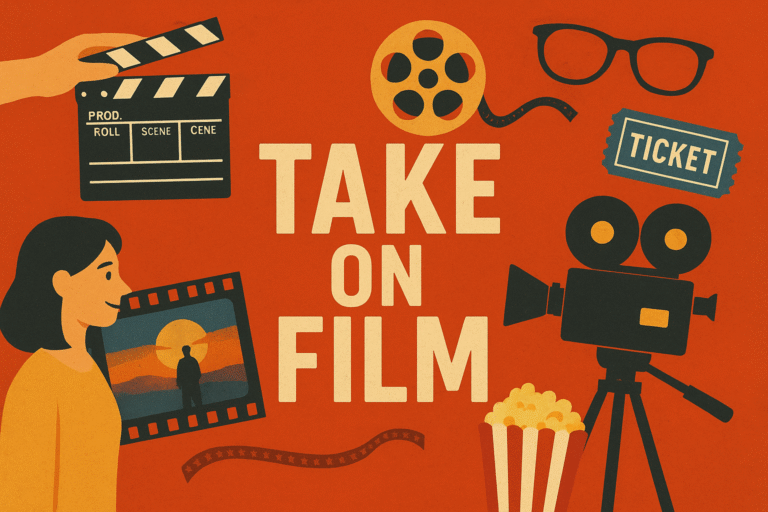Introduction
When was the last time a movie made you sit back, whisper “Wow,” and question how it was even made? That moment—that spark—is what keeps the art of filmmaking alive. A take on film isn’t just about watching; it’s about seeing, interpreting, and feeling. It’s about looking beyond the surface to understand the craft, emotion, and imagination that shape every frame.
In this article, we’ll explore the essence of cinema, peel back the layers of storytelling, and examine how fresh perspectives keep audiences captivated. Ready to reimagine your own take on film? Let’s roll the reel!
The Magic of a Take on Film
A take on film can be as simple as a personal review or as deep as a philosophical reflection. But what makes it special? Let’s break it down:
-
Perspective – Everyone sees a movie differently, based on their life experiences, beliefs, and mood at the time.
-
Cinematic Craft – Directors, cinematographers, and editors create visual poetry using framing, lighting, and pacing.
-
Emotional Impact – A film’s ability to move audiences—make them cry, laugh, or scream—is the heartbeat of storytelling.
How Storytelling Evolves in Cinema
One reason why films remain timeless is their constant reinvention of narrative style. Here are a few storytelling trends that keep shaping our collective take on film:
1. Non-Linear Narratives
Ever seen a movie where scenes jump back and forth in time? Memento, Pulp Fiction, and Eternal Sunshine of the Spotless Mind proved that audiences love piecing together a puzzle. Non-linear narratives challenge traditional structures, inviting viewers to participate actively in the storytelling process.
2. Visual Symbolism
Directors like Stanley Kubrick and Denis Villeneuve use imagery to speak volumes without dialogue. A lingering shot of an empty hallway, a flickering light, or a recurring color palette can communicate layers of meaning—if you know where to look.
3. Breaking Genre Boundaries
Gone are the days when films neatly fit into “comedy,” “drama,” or “action.” Today, a movie can be a sci-fi rom-com thriller (think Everything Everywhere All At Once). This blending of genres keeps storytelling fresh, surprising, and emotionally complex.
The Role of Technology in Shaping Our Take on Film
Let’s be real—technology has flipped the filmmaking world upside down. From CGI spectacles to indie films shot on iPhones, the tools have never been more versatile.
-
CGI & VFX Revolution – Films like Avatar and Dune show how digital worlds can feel startlingly real.
-
Streaming Platforms – Netflix, Amazon Prime, and Disney+ have changed how we consume cinema, offering instant access to diverse storytelling.
-
AI in Filmmaking – Yes, AI can now edit footage, design visual effects, and even help write scripts. But does that risk losing the human touch?
Personal Takes on Film: Why They Matter
Here’s the thing—your personal take on film matters just as much as a critic’s review. Why? Because movies aren’t just art; they’re mirrors reflecting our own lives, fears, and dreams.
-
Nostalgia-Driven Views – Sometimes we love a film because it reminds us of a childhood memory.
-
Contextual Interpretations – A war film might resonate differently with a veteran compared to a casual viewer.
-
Cultural Perspectives – International cinema offers a whole new lens on human experience—think Parasite or RRR.
Cinematic Elements That Shape Interpretation
When dissecting your take on film, it helps to look at the key elements shaping your viewing experience:
Cinematography
-
Camera angles, lighting, and composition influence how a story feels.
-
Close-ups can evoke intimacy, while wide shots create distance or grandeur.
Sound Design
-
Music, dialogue, and ambient noise all stir emotions. Ever noticed how a horror scene feels ten times scarier with the right soundtrack?
Editing
-
A film’s rhythm lives in its cuts. Quick edits create tension; slow ones invite reflection.
Why Critics and Audiences Often Disagree
Ever wondered why a critically acclaimed film sometimes flops at the box office—or vice versa? It’s all about perspective.
-
Critics often analyze artistic merit, symbolism, and technical innovation.
-
Audiences focus on emotional connection, relatability, and entertainment value.
-
The sweet spot? A film that balances both—visually stunning and deeply moving.
Frequently Asked Questions (FAQs)
1. What does “take on film” really mean?
It refers to a personal perspective, opinion, or interpretation of a movie or the art of filmmaking itself.
2. Can two people have completely different takes on the same film?
Absolutely! That’s the beauty of cinema—its meaning evolves with each viewer’s experience.
3. Why do some films age better than others?
Timeless themes, strong storytelling, and innovative techniques ensure certain films remain relevant, no matter the era.
4. Do streaming platforms change our take on film?
Yes. They’ve democratized access to diverse genres and international cinema, broadening how we interpret and value films.
Conclusion
Cinema isn’t just about watching—it’s about experiencing, questioning, and interpreting. Your unique take on film—whether it’s shaped by emotion, aesthetics, or personal history—adds to the ever-expanding conversation around what makes movies magical.
So, next time you press play, ask yourself: What’s my take on film today? You might just find a whole new way to appreciate the art form.

